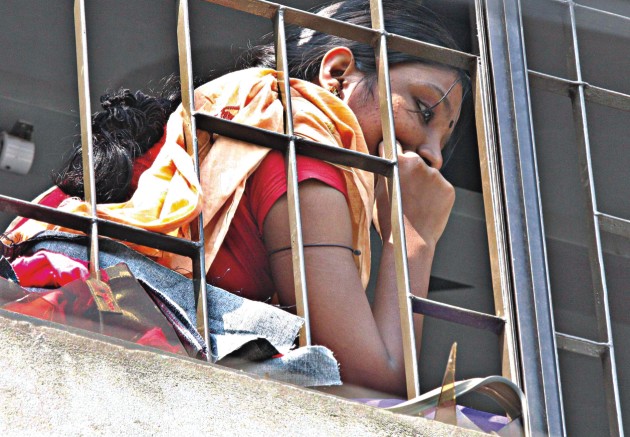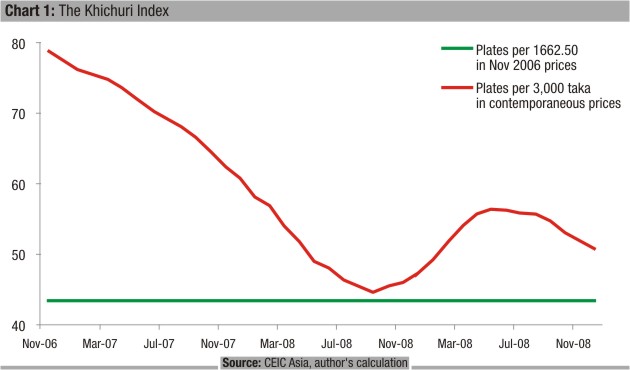
Inside
|
Unanswered Questions about the
‘Don’t come around today, gondogol' -- the text-message blipped on my phone. Garments workers were allegedly going on a rampage in Gulshan, protesting the minimum wage award that was announced earlier that week. According to eyewitness accounts, the people attacking the Wal-Mart office -- a major buyer -- didn't look like a spontaneous mob. There were all sorts of speculations: war criminals were behind this; oh no, it was the Indians out to destroy our economy. And these I heard not just in political addas over cha-nashta but also in TV talk shows attended by supposedly knowledgeable people. Everyone was giving strong, polarised opinions: "Our garment workers are treated like slaves and nothing short of a 5,000 taka minimum wage will do" versus "a 3,000 taka minimum wage will decimate our global competitive edge". Meanwhile, I heard garment workers in the Ashulia-Savar belt, and their employers too, worry about exactly what the policy entailed and what the future would hold. Then, within a few days, our "chatterati" culture forgot the whole issue. But this is not an ordinary issue. Readymade garments account for well over three-quarters of our exports. Millions are dependent on jobs in the sector. Social benefits derived from female participation in the sector rival the best efforts of government and non-government development agencies over the past few decades. This is an issue that deserves far greater attention and deeper analysis than what we have seen. I ask some questions in this piece that should have been raised in policy dialogues and seminars. It is incredible that our think tanks and policy researchers haven't tackled these questions either. Is this a living wage? The consumer price index (CPI) for urban areas had risen by about a third between November 2006 and June 2010. So at first glance, it would seem that the nearly doubling of the minimum wage is quite generous. But is the CPI for all city dwellers a good gauge of garment workers' cost of living? The Bangladesh Bureau of Statistics doesn't provide a basket for garments workers. However, monthly retail prices for some essentials -- the proverbial rice, lentil, oil and salt -- are available until 2009. Throw in a kilogram of coarse rice, 250 grams of red lentil, 40 ml soya bean oil and 10 mg salt and we get a rather bland plate of khichuri. In November 2006, with the then monthly minimum wage, one could buy 43 such plates, while 3,000 taka would have fetched 79 plates. Rising prices in 2007 and 2008 eroded the purchasing power of taka, and by December 2009, 3,000 taka could get one only 51 plates (Chart 1). When evaluated against price increases of essential goods, the minimum wage has been raised by only a sixth, not nearly doubled.
Of course, one can't just eat khichuri, one has to live somewhere too. I don't have a series on rents in Dhaka slums, but I'd hazard a guess that it has moved up quite a bit since 2006. Perhaps most importantly, how does one know that the 2006 minimum wage was sufficient to cover subsistence? In 2005, the poverty threshold in Dhaka was estimated to be 890 taka per person per month. Even accepting this poverty line, the 2006 minimum wage was sufficient to cover 1.9 persons' subsistence. How many persons does an entry-level garments worker provide for? Remarkably, five years of urbanisation, inflation, remittance boom and 5.5-6 percent economic growth later, the 2005 estimate is still the best guide to the poverty line. So there is no way of formally gauging what would be a reasonable award now. What about the fine print and unintended consequences? Even if all these worries are completely unfounded, the government and the so-called labour leaders who accepted the deal on behalf of the workers have done an abysmal job of explaining the facts to the workers. Of course, with the chattering classes, media and government moving on to the next hot topic, no one will hold anyone to account. And there may well be good grounds for concern. Let me use the overtime conditions as an example. Under the old award, workers could avail as much as 2,400 taka a month in overtime pay. Of course, this involved extremely long work hours. The new award limits a day's work to 12 hours, with four hours of potential overtime pay. In theory, this is a welcome move that ensures humane working conditions. But the reality may well be different. In practice, there is a risk that a worker will have to work 15-16 hours on some days to meet production deadlines, but will earn only 12 hours of pay, including overtime. In practice, it is quite possible that the monthly overtime pay will be limited to around 1,000 taka. In practice, after accounting for the overtime, the entry-level worker may well see no pay rise at all! These back-of the-envelope calculations might not be wholly accurate, but they are based on the information made available to the public. Either additional information or rigorous analysis must be released, or measures need to be enacted to avoid new forms of worker exploitation. Will smaller factories be hit harder? The award is not just for the minimum wage for entry-level workers. It affects all seven grades of workers. A similar pay rise for the skilled, mid-level workers may hit the bottom line harder, particularly of smaller factories. Consider this scenario. The small factory owner finds it relatively harder to meet the mandatory pay-rise. To save on other costs, general working conditions decline. In practice, the overtime scenario described above comes true even if the owners are not particularly malevolent. Relatively skilled mid-level workers leave the smaller firms for larger ones, who are better able to provide better working conditions. The net result is that smaller firms are squeezed out of existence. Supporting small and medium sized enterprise is a key development strategy of the government. It would be counterproductive to broader economic growth strategies if a supposedly egalitarian policy is at odds with this development objective. Again, current reporting makes it impossible to know how likely or widespread an adverse impact on the smaller factories is. But at this point, a serious disjunct in economic development strategies appears possible and warrants further analysis. What will be the hit on the bottom line?
First, how will the buyers react? According to academic research, a doubling of labour costs typically increases Western retail prices by 1 to 3 percent. And Bangladesh isn't the only country where there is upward wage pressure -- it's a regional story. For example, monthly minimum wage in the Cambodian garment sector is about 3,500 taka, and there is labour agitation for a raise to 4,200 taka. Monthly minimum wage has risen to about 3,650 taka for the foreign-owned firms in Vietnam. These two countries are usually considered Bangladesh's major competitors. Indeed, according to some estimates of relative labour costs, Bangladesh had a strong competitive edge in 2008 that can, all else being equal, withstand such pay-rises (Chart 2). And this is all in the shadow of rising labour costs in China that is likely to affect global supply chains in profound and as yet unpredictable ways. And what about productivity? In addition to global factors, whether the new award is affordable for owners depends on evolving productivity trends in the industry. A garment worker's productivity rises when hand finishing can be done on a machine, or when older machines are replaced with newer models. Her productivity also rises with better management techniques. All else being equal, higher pay is affordable if concurrent shifts in technique enable her to produce more in a given hour. What has been the trend in productivity in the readymade garments sector in recent years? Remarkably, there is no data. Even more remarkably, productivity and unit labour costs are not even mentioned in most discussions of the issue. Anecdotal evidence is that the severe electricity crisis and a shortage of skilled supervisors inhibit productivity gains in the industry. This may be true, but by how much? Shockingly, no one knows.
Questions, but no answers There are personal stories. There are conjectures and conspiracy theories. There are opinions and counter opinions. But what's missing is data, evidence, research and analysis. In a country kept economically afloat by garment manufacture, that's simply not good enough. Further reading Jyoti Rahman is an applied macroeconomist who writes with Drishtipat Writers' Collective (www.drishtipat.org/dpwriters). He can be contacted at dpwriters@drishtipat.org.
|



